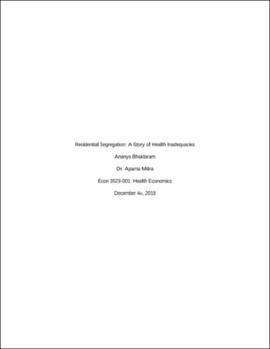| dc.creator | Ananya Bhaktaram | |
| dc.date.accessioned | 2020-05-26T01:54:01Z | |
| dc.date.accessioned | 2021-04-14T14:56:32Z | |
| dc.date.available | 2020-05-26T01:54:01Z | |
| dc.date.available | 2021-04-14T14:56:32Z | |
| dc.date.issued | 12/4/18 | |
| dc.identifier.uri | https://hdl.handle.net/11244.46/1545 | |
| dc.description.abstract | The intentional segregation of metropolitan areas in the United States during the twentieth century has resulted in rising health disparities in low-income minorities today. Contemporary medical practices like collecting health data by race and not by socioeconomic status obfuscates the problem. OneÕs geography of opportunity, meaning the opportunities one is afforded based on where you live has direct effects on your prospective health. Low income minorities are faced with greater adverse risk because they are more likely to be found in a double jeopardy situation where they are simultaneously impoverished and living in a bad neighborhood. Additionally, treatment within the healthcare system itself is often times sub-par. | en_US |
| dc.description.abstract | University Libraries Undergraduate Research Award | en_US |
| dc.format.medium | Text | |
| dc.language | eng | |
| dc.relation.ispartofseries | No | |
| dc.subject | University Libraries Undergraduate Research Award | |
| dc.title | Residential Segregation: A Story of Health Inadequacies | |
| dc.type | Article | |
| dc.description.peerreview | No | en_US |
| dc.description.undergraduate | undergraduate | |
